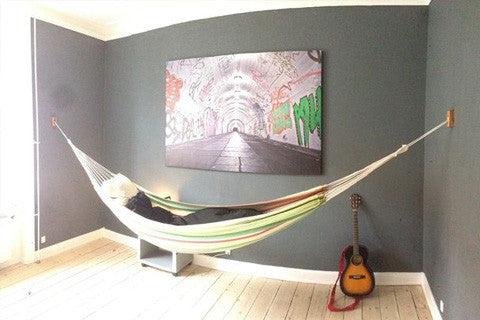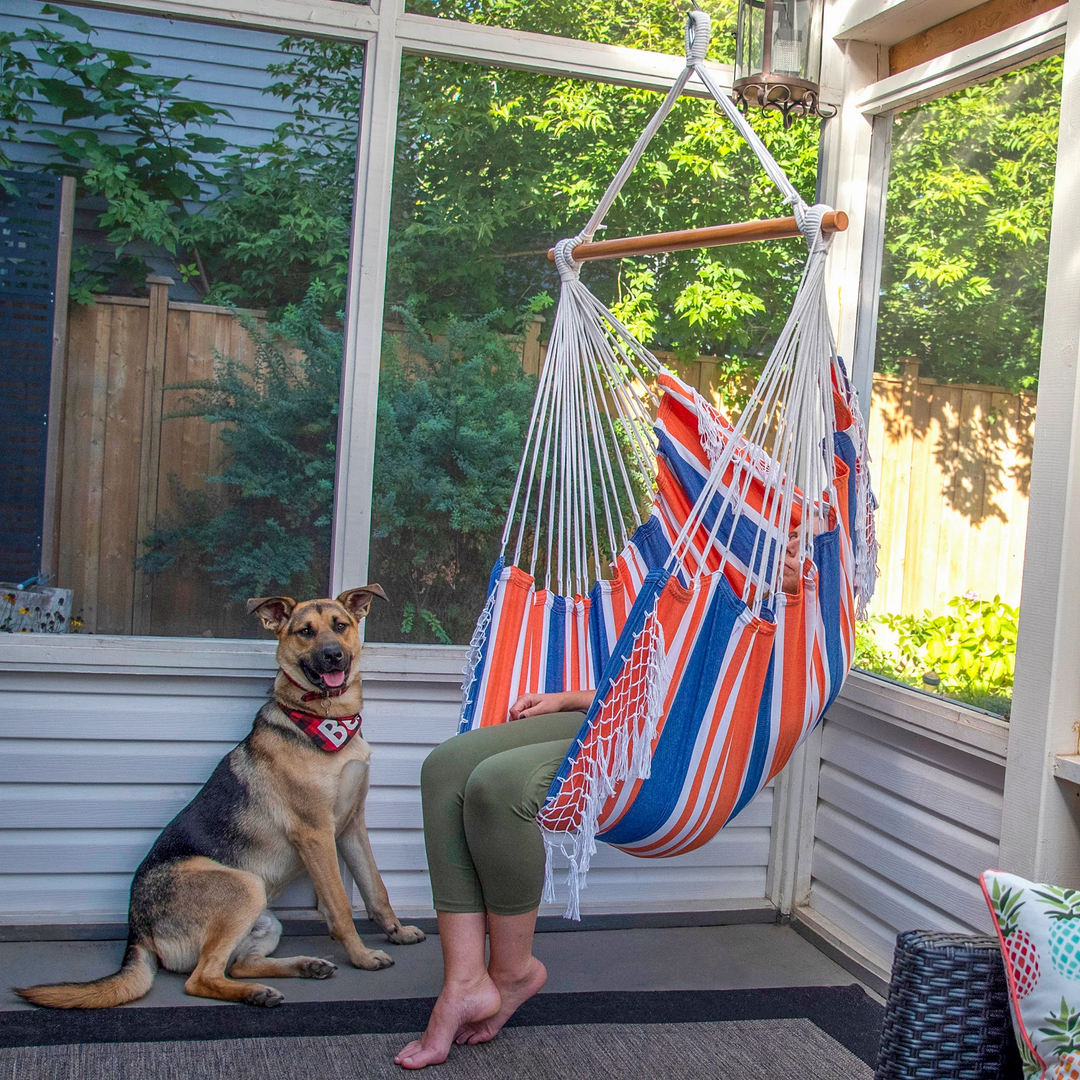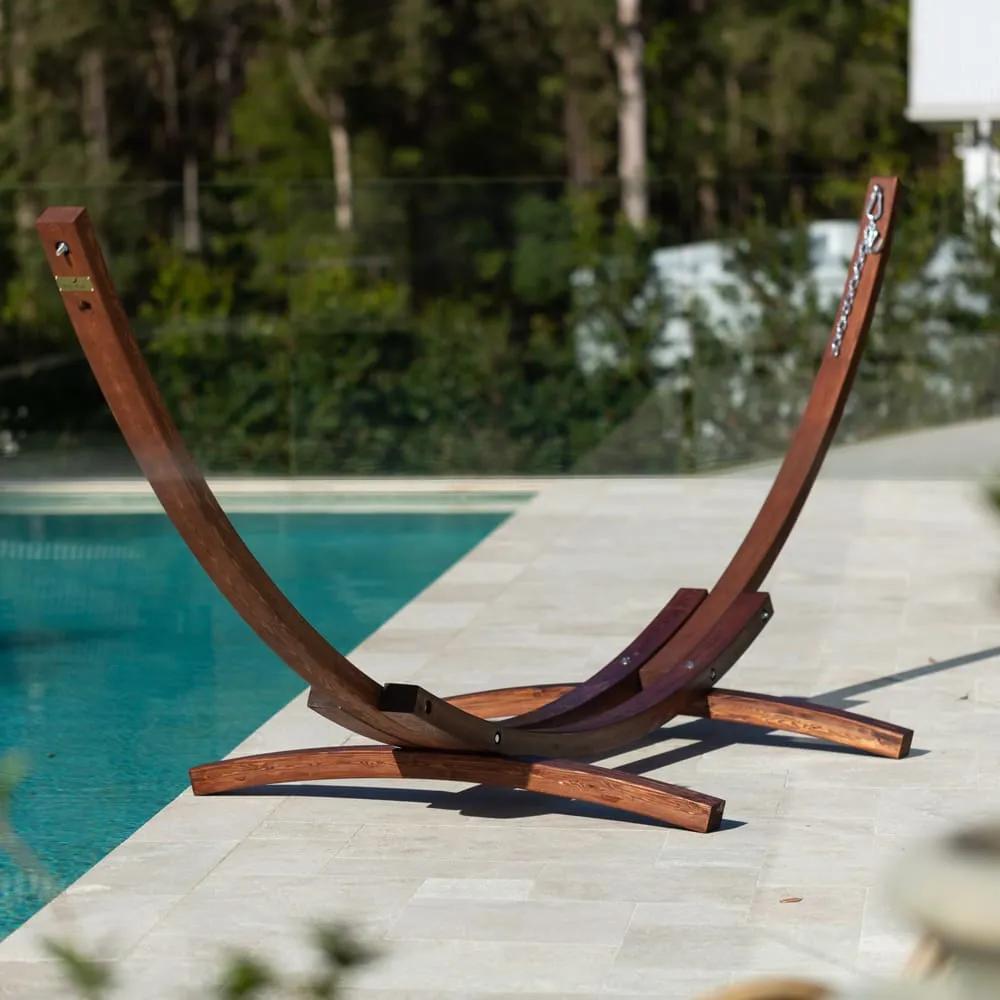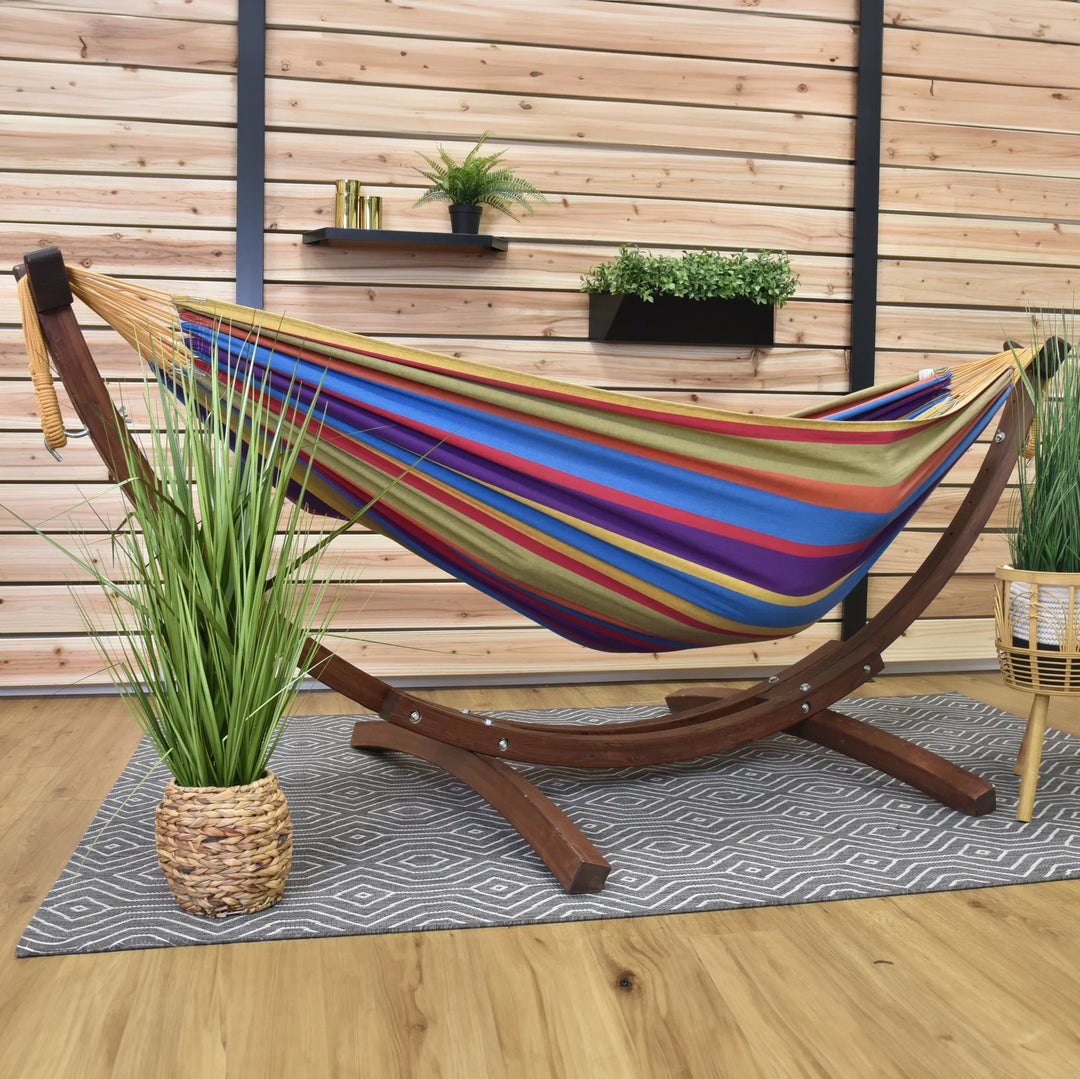Hammock FAQ
Siesta Hammocks - Hammock FAQ

- What Hammock to Choose?
- What is the difference between Brazilian, Mexican and Nicaraguan Hammock?
- How to hang my hammock?
- What's the weight capacity of hammocks?
- How long can I expect my hammock to last?
- What is the difference between steel stand and a wooden stand?
- Will tree hooks damage my trees?
- How do I determine the ideal amount of space for hanging my hammock?
- Are there any important safety precautions I should take when using my hammock?
What Hammock to Choose?
You can find different kinds of hammocks, hammock chairs and portable hammocks for your patio and garden. Each hammock style has its qualities, and one is sure to be perfect for your patio.
What is the difference between Brazilian, Mexican and Nicaraguan Hammock?
Brazilian Hammocks
Brazilian hammocks are cross woven fabric hammocks, frequently colorful, and often beautifully adorned. One of the most comfortable sleep systems in the world is the Brazilian double hammock bed, which is still widely used in the rural areas of Brazil.
As they are produced to be used as beds, they are extremely comfortable and supportive, about as different from a double rope hammock as can be imagined.
The Brazilian hammock, being woven in fabric, is less cooling in the summer heat than the open weave style. By the same token, however, they are splendid for cooler climates and mild weather use.
Nicaraguan Hammocks
The Hammocks of Nicaragua are considered to be the most luxurious of all hammocks, and among the most beautifully adorned. They are excellent as beds or as comfortable "hang outs" inside or out.
Handcrafted in Nicaragua by skilled artisan workers, a ton of work and precision goes into the making of these beautiful Nicaragua hammocks. The soft-spun cotton material offers extreme comfort, and each Nicaragua hammock is tightly-woven and double-layered for an enhanced relaxing experience and unmatched durability.
Mexican Hammocks
For a hammock that is known for its top-of-the-line comfort, the Mayan hammocks may just be the perfect choice. Considered by hammock experts to be one of the most comfortable, these Maya hammocks are handcrafted by skilled artisans in the Yucatan Peninsula for unsurpassed quality and workmanship.
Using the efficient weaving mechanism that has been used by Mayan hammock makers for centuries, the traditional technique calls for unmatched workmanship using a diamond string pattern that provides a superb feeling of heavenly weightlessness.
How to hang your hammock?
So you've bought a hammock and you're keen to start using it right away. But you're worried that it requires expert skills to hang and you're keen to avoid falling to the ground with a great big thump. Well guess what? Hanging a hammock is actually really easy and there is no magic way of doing it. So don't let anyone tell you otherwise!
We have listed a few different ways to hang a hammock along with the stand, accessories and tips you will need to get started:
Hammock on a stand

Hanging your hammock on a stand is the easiest way as all the hard work has been done for you, especially if you go for one of our Hammock Bundles.
Between two trees

To fix a hammock to a tree you will need a hammock and a rope fixing like our Hanging Tree Pack or Hanging Tree Pack with Chains. The ropes wrap around each tree and then link to the loops on your hammocks. Both these ropes are adjustable so you can increase or decrease the tension to suit the distance between your trees.
At Siesta Hammocks we often spend our lunch in the surrounding forests near our office. No two trees are exactly the same and we don't have any trouble finding a way to hang our hammocks thanks to how adjustable these accessories are.
Helpful Tip: Measure the distance between your two desired trees. Choose your hammock. Now ensure the hammocks total length is at least 1m less than the total distance between the trees to give enough distance for your hanging tree packs.
Between two concrete/brick walls

To attach your hammock to a wall you will need a Screw hook kit which you can drill into the wall securely. If you want to give your hammock further flex, you can add a hammock spring which will make it springier but is usually used for when hanging a chair from the ceiling.
Wooden posts or beams

Fixing a hammock into wood is easy and often customer choose to hang the hammock from beams on the roof, ones which run down the wall or even sink their own post in the groud with concrete to create a homemade post. A Hammock Hanging Kit should do the trick which is made especially for hanging your hammock from wooden posts or beams.
We can also provide you with some insights on how to build a hammock stand

- It has just three basic parts – the base, the uprights, and the braces.
- In fact, with the plans, you can make this in just an afternoon and be relaxing in it the same night!
- Using a redwood for this build because it is one of nature’s strongest materials and resists warping and splitting and is naturally rot-resistant.
Mounting it in a ceiling

If you want to create a larger arch or hang a hammock chair, then you will need our Screw Hook kit or Hanging Kit pack which will suspend your hammock from a fixed point on the ceiling.
What is the difference between steel stand and a wooden stand?
If you just want to skip all the info and want a suggestion on one of the best hammock with stand sets, check out our favorite model, the double size hammock with wooden frame and the double size hammock with steel frame. It’s the perfect combination of size, style, durability and value.
Benefits of the steel hammock stand
There are a couple of benefits about the hammock stand that you need to know. This is the only way to make sure that you know that you are going to choose the right hammock stand, for you and your needs. These are some of the benefits that you will get from the steel hammock stand:
- It is durable and long lasting.
- It is lightweight and can be moved around where you want to enjoy the hammock.
- They are normally lower in price, even if they are more durable.
- The steel hammock stand is protected against all weather conditions.
- It is easy to assemble when you are buying the steel hammock stand.
- They are taking up less space than other hammock stands.
Benefits of the wooden hammock stand
With the wooden hammock stand, there are also a great number of benefits and advantages that you need to know before you can know which one you should choose for your hammock. These are some of the common reasons why you should choose a wooden hammock stand.
- It looks a lot more beautiful when you are making use of the wooden hammock stand.
- It is great for using outdoors.
- The wooden hammock stand provides more stability and more people can enjoy the hammock with you. It won’t bend or break when you are too heavy for the stand.
- There are a variety of types of wood hammock stands that you can. purchase. Some are thicker and larger than other hammock stands.
- The wooden hammock stand looks more modern and stylish.
How can I clean or wash my hammocks?
In general, don't let leaves, sticks and other yard debris accumulate in your hammock. Beyond that, periodic cleaning is key.
- For our cotton rope – Soak the hammock in mild soapy water and then rinse the rope with a hose. Let your hammock hang to dry, or else lay it on a clean, flat surface. Keep the spreader bars out of the water as much as possible.
- For our Nylon – Using a mild soapy-water solution, scrub the hammock rope gently with a soft-bristled brush, then rinse the rope thoroughly with a hose. For more intensive cleaning, you can use a solution that's one part bleach to four parts soapy water. Keep the spreader bars out of the water as much as possible.
- For our Mexican – Follow the suggestions for cleaning nylon, though instead of using a brush for scrubbing, we suggest rubbing the rope against itself.
- For our quilted fabrics – In general, light spot cleaning is best. Our quilted hammocks contain polyester fiber-fill batting; cleaning too vigorously can cause the batting to bunch up, and it may be difficult to get it to return to its original shape. If more extensive cleaning becomes necessary, carefully wash using a mild soap-and-water solution and a soft-bristled scrub brush. Rinse completely with a hose, then hang your hammock back up to let it air-dry. Store-bought spot-remover solutions can also be used for problem areas.
- For our camping hammocks – Using a mild soapy-water solution, scrub the fabric gently with a soft-bristled brush. Rinse completely with a hose, then hang your hammock back up to let it air-dry. For more serious cleaning, try using a solution that's one part bleach to four parts soapy water. Keep the spreader bars out of the water as much as you can.
Will tree hooks hurt my trees?
No, they shouldn't affect the health of your trees; however, tree hooks will leave behind holes should you ever decide to remove the hooks. For that reason, we recommend using tree straps instead. Tree straps require no drilling and allow easy changing of hammock height – plus you get the added convenience of easily being able to move your hammock from place to place whenever you want!
What's the weight capacity of each Hammock?
All of our hammocks will hold up to 200kgs. (The weight capacity for our swings and stands, however, varies by product, from 200 kgs up to 250kgs.
Check individual product and the original packaging of your product came in, for specific weight capacities.)
How do I determine the ideal amount of space for hanging my hammock?
The ideal hanging distance typically averages out to about 2 feet greater than the total length of a hammock, which is measured from ring to ring. Generally speaking, you should plan on needing about 15 feet of open space for hanging your hammock, though the actual distance can vary anywhere from 13-16 feet. Keep in mind that the closer your hanging points are to each other, the greater the arc, or curve, your hammock is going to have once it's hung.
How long can I expect my hammock to last?
There's no simple answer to this question. Climate, care and maintenance of the hammock, along with the materials from which it is crafted all greatly affect how long it will last. Particularly if the hammock rope is made from a natural fiber such as cotton, the hammock's lifespan can be as short as one year if proper care is not taken to protect it from the elements.
However, if a hammock is routinely cleaned, and also taken down and stored during periods of bad weather, it's not uncommon for even a cotton-rope model to last for upwards of 20 years; hammocks made from quality materials like our hand-made Mexican Hammocks made of Nylon, can last indefinitely if properly cared for.
So regardless of the material from which your Siesta Hammocks is crafted, the amount of care you invest in it will profoundly affect the length of its useful life.

Distance measured from ring to ring when hammock is laid flat on the floor.
Please Note: A new hammock may be up to 2 feet shorter than its specifications, to allow for its ropes' natural tendency to stretch the first few times the hammock is used.
Are there any important safety precautions I should take when using my hammock?
Yes, make sure to take note of it:
- Don't exceed your hammock's stated weight limit. Falling can really hurt.
- Always place your weight in the center of your hammock, not on either edge. See note on falling, immediately above.
- Don't allow young children to use the hammock without adult supervision. Don't EVER place infants in any hammock.
- Don't allow your children to jump up and down in your hammock or use it like a playground swing. Not only is this extremely dangerous, but it puts excessive wear and tear on the hammock and its hanging hardware.
- Don't let hammock chains get twisted and don't flip your hammock over while it's hung; both severely compromise chain strength.
- Always inspect your hammock before getting into it – squirrels, mice, birds and bugs sometimes use hammock-rope fibers to build nests and to live in, and weakened rope may give way under pressure. Have we mentioned that falling can hurt?





